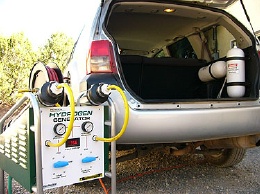 By David Ponce
By David Ponce
$7,000 to $10,000 will soon be able to buy you a kit that transforms your car from a dirty gas guzzler into an eco-friendly hydrogen burner. In other words, you’ll be able to run your car on either gasoline, or hydrogen.
That’s right. With some special kits being developed by company United Nuclear, you won’t be using hydrogen as energy source for a fuel cell, like most of today’s hydrogen-as-energy source solutions. You’ll instead simply use the hydrogen as the fuel. And you won’t have to go around looking for places to purchase this hydrogen either. You’ll manufacture it yourself.
The system comes in two parts. First, you have the Hydrogen fuel system in your vehicle, and then a Hydrogen generating system that remains in your garage. The Hydrogen generator is either powered by solar electric panels or a wind turbine set-up, either of which makes Hydrogen fuel at virtually no cost. This hydrogen is then stored in hydride tanks.
The tanks are filled with granulated Hydrides, and Hydrogen is pressurized into the material. Hydrides have many advantages over liquid & gas. One is that the density of the Hydrogen stored in the Hydride can be GREATER than that of liquid Hydrogen. This translates directly into smaller and fewer storage tanks.
Once the Hydride is “charged” with Hydrogen, the Hydrogen becomes chemically bonded to the chemical. Even opening the tank, or cutting it in half will not release the Hydrogen gas. In addition, you could even fire incendiary bullets through the tank and the Hydride would only smolder like a cigarette. It is in fact, a safer storage system than your Gasoline tank is.
Then how do you get the Hydrogen back out? To release the Hydrogen gas from the Hydride, it simply needs to be heated. This is either done electrically, using the waste exhaust heat, or using the waste radiator coolant heat.
Our kits heat the Hydride tanks electrically, and as soon at the Hydride is sufficiently warm, Hydrogen is released from the tanks and the on-board computer detects the presence of Hydrogen pressure. The fuel system remains in “Hydrogen” mode until the tank pressure begins to drop. If the tanks run out of Hydrogen, the engine will seamlessly switch over to Gasoline, which enables the car to run conventionally until the Hydrogen tanks are refilled.
I say this is brilliant. I also say I’m a little worried about all the spelling mistakes on these people’s site. So I’m keeping my fingers crossed that this actually ever sees the light of commercial day. Check out the website. Story VIA Digg.




[…] United Nuclear’s Hydrogen Fuel Systems […]
sounds like it would make for a spectacular accident on the 6 o’clock news
That’s been a supposition with hydrogen-burning cars for a long time. If they can make scuba tanks that can be reused thousands of times without blowing up (they have something like 1200 psi of air in them), then I’m sure that they can make safe hydrogen tanks. Gasoline vapor is even more explosive than hydrogen gas, and you get a hell of a lot of gasoline vapor when you rupture a gas tank, yet explosions from auto accidents that are caused by exploding fuel from a ruptured tank are extremely rare, despite the location and construction of most fuel tank (thin-gauge metal or, more recently, injection-molded platic).
I have carried around scuba takes in the back of my car for long periods of time, for miles and miles. They frequently have 3000 psi or even slightly more and I have never had a single problem. These tanks are strong. People have their sense of reality too deeply defined from movies.
Hydrogen storage is much safer than gasoline. Hydrgoen gas is lighter than air so if there is a leak the gas extends upward instead on the ground like a liquid. Hydrogen gas is odor free unlike gasoline. besides to get the really nice movie like explosions, you need to add oxygen. I have been driving around on hydrogen hybrid Lancruiser for about year. Used properly it’s the safest gas on the Planet!